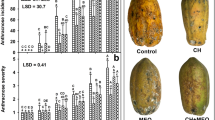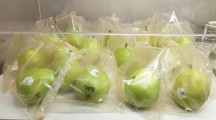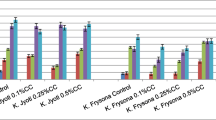Abstract
The effect of a chitosan coating on antifungal activity and rate of respiration, chitinase and β, 1-3 glucanase activities with reference to papaya variety ‘Rathna’ was investigated. One percent chitosan, extracted from locally available prawn waste, was selected as the effective concentration to inhibit spore germination via a series of experiments on potato dextrose agar. Rate of respiration and the concentration of CO2 in the internal cavity of chitosan-treated and untreated papaya were tested via gas chromatography. Chitinase and β,1-3 glucanase activities were tested in peel samples using gel diffusion and spectrophotometric assays, respectively. Complete inhibition of spore germination was observed in-vitro at treatments of 1% chitosan and above. This concentration significantly (P < 0.05) reduced both disease incidence and severity on inoculated fresh papaya. Significant (P < 0.05) decrease was observed in rate of respiration while internal CO2 concentration of the fruit increased (P < 0.05) with the chitosan treatment. Chitinase and β,1-3 glucanase activities of papaya variety Rathna subjected to chitosan treatment were much higher than in the untreated control. Chitosan shows antifungal activity to the anthracnose disease causing fungus and stimulates the defense response on the papaya peel by increasing the chitinase and β,1-3 glucanase activities. The antifungal activity of chitosan could be attributed to the induction of elicitation activity due to these defense enzymes. It also forms a semi-permeable coating around the fruit and extends storage life of papaya by reducing the rate of respiration and delaying ripening.




Similar content being viewed by others
References
Arlorio, M., Ludwig, A., Boller, T., & Bonfante, P. (1992). Inhibition of fungal growth by plant chitinase and β, 1-3 glucanase: a morphological study. Protoplasma, 171, 34–43.
Bai, R. K., Huang, M. Y., & Jiang, Y. Y. (1988). Selective permeability of chitosan—acetic acid complex membrane and chitosan—polymer complex membrane for oxygen and carbon dioxide. Polymer Bulletin, 20, 83–88.
Bautista-Banos, S., Hernandez-Lopez, M., Bosquez-Molina, E., & Wilson, C. L. (2003). Effect of chitosan and plant extracts on growth of Colletotrichum gloeosporiodes, anthracnose levels and quality of papaya fruit. Crop Protection, 22, 1087–1092.
Benhamou, N. (1996). Elicitor induced plant defense pathways. Trends in Plant Science, 1, 233–240.
Benhamou, N., Kloepper, J. W., & Tuzun, S. (1998). Induction of resistance against Fusarium wilt of tomato by combination of chitosan with endophytic bacteria strain: ultrastructure and cytochemistry of the host response. Planta, 204, 153–168.
Bhaskara Reddy, B. M. V., Asselin, A., & Arul, J. (1997). Effect of chitosan on tissue maceration and enzyme production by Erwinia carotovora in potato. Proceedings of the 94th Annual Meeting, International Conference of the American Society for Horticultural Science (Salt Lake City, UT, USA).
Chien, P. J., & Chou, C. C. (2006). Antifungal activity of chitosan and its application to control postharvest quality and fungal rotting of Tankan citrus fruit (Citrus tankan Hayata). Journal of the Science of Food and Agriculture, 86, 1964–1969.
Chien, P. J., Sheu, F., & Lin, H. R. (2007a). Coating citrus (Murcott tangor) fruit with low molecular weight chitosan increases postharvest quality and shelf life. Food Chemistry, 100, 1160–1164.
Chien, P. J., Sheu, F., & Yang, F. H. (2007b). Effects of edible chitosan coating on quality and shelf life of sliced mango fruit. Journal of Food Engineering, 78, 225–229.
Dann, E. K., & Deverall, B. J. (2000). Activation of systemic disease resistance in pea by an avirulent bacterium or a benzothiabendiazole, but not by a fungal leaf spot pathogen. Plant Pathology, 49, 324–332.
Du, J., Gemma, H., & Iwahori, S. (1998). Effects of chitosan coating on the storability and on the ultrastructural changes of ‘Jonagold’ apple fruit in storage. Food Preservation Science, 24(1), 23–29.
El-Ghaouth, A., Arul, J., & Ponnampalam, R. (1991a). Use of chitosan coating to reduce water loss and maintain quality of cucumbers and bell pepper fruits. Journal of Food Processing and Preservation, 15, 359–368.
El-Ghaouth, A., Arul, J., Ponnampalam, R., & Boulet, M. (1991b). Chitosan coating effect on storability and quality of fresh strawberries. Journal of Food Science, 56, 1618–1620.
El-Ghaouth, A., Arul, J., Grenier, J., Benhamou, J., Asselin, A., & Belanger, R. (1994). Effect of chitosan on cucumber plants: suppression of Pythium aphanidermatum and induction of defense reactions. Phytopathology, 84, 313–320.
Hwang, Y. S., Kim, Y. A., & Lee, J. C. (1998). Effect of postharvest application of chitosan and wax and ethylene scrubbing on the quality changes in stored “Tsugaru” apples. Journal of Korean Society of Horticultural Science, 39, 579–582.
Jianming, D., Hiroshi, G., & Shuichi, I. (1997). Effects of chitosan coating on the storage of peach, Japanese pear and wiwifruit. Journal of the Japanese Society of Horticultural Science, 66, 15–22.
Kittur, F. S., Saroja, N., Habibunnisa, & Tharanathan, R. N. (2001). Polysaccharide-based composite coating formulation for shelf-life extension of fresh banana and mango. European Food Research Technology, 213, 306–311.
Park, S. I., Stan, S. D., Daeschel, M. A., & Zhao, Y. (2005). Antifungal coatings on fresh strawberries (Fragaria x ananassa) to control mold growth during storage. Journal of Food Science, 70, 202–207.
Reddy, B. M. V., Belkacemi, K., Coycuff, R., Castaigne, F., & Arul, J. (2000). Effect of pre-harvest chitosan sprays on post-harvest infection by Botrytis cinerea and quality of strawberry fruit. Postharvest Biology and Technology, 20, 39–51.
Sathyabama, M., & Balasubramanian, R. (1998). Chitosan induces resistance components in Arachis hypogaea against leaf rust caused by Puccinia arachidis Speg. Crop Protection, 17, 307–313.
Sivakumar, D., Hewarathnagamagae, N. K., Wilson Wijeratnam, R. S., & Wijesundara, R. L. C. (2002). Effect of ammonium carbonate and sodium bicarbonate on anthracnose of papaya. Phytoparasitica, 30, 486–492.
Sivakumar, D., Sultanbawa, Y., Ranasingh, N., Kumara, P., & Wijesundara, R. L. C. (2005). Effect of the combined application of chitosan and carbonic salts on the incidence of anthracnose and the quality of papaya during storage. Journal of Horticultural Science and Biotechnology, 80, 447–452.
Tejchgraber, P., Popper, L., & Knorr, D. (1991). Chitosan as an elicitor for the production of chitinase, an antifungal enzyme from soybean seeds. Agro-food Industry Hi-Technology, 2, 11–14.
Trudel, J., & Asselin, A. (1989). Detection of chitinase activity after polyacrylamide gel electrophoresis. Analytical Biochemistry, 178, 362–366.
Vargas, M., Albors, A., Chiralt, A., & Gonzalez-Martinez, C. (2006). Quality of cold-stored strawberries as affected by chitosan-oleic acid edible coatings. Postharvest Biology and Technology, 41, 164–171.
Zhang, D., & Quantick, P. C. (1997). Effects of chitosan coating on enzymatic browning and decay during fruit postharvest storage of litchi (Litchi chinensis Sonn.) fruit. Postharvest Biology and Technology, 12, 195–202.
Zhang, D., & Quantick, P. C. (1998). Antifungal effects of chitosan coating on fresh strawberries, and raspberries during storage. Journal of Horticultural Science and Biotechnology, 73, 763–767.
Zou, X., Nonogaki, H., & Welbaum, G. E. (2002). A gel diffusion assay for visualization and quantification of chitinase activity. Molecular Biotechnology, 22, 19–23.
Acknowledgments
We gratefully acknowledge the financial assistance provided by the ITI Treasury Grant, Ministry of Science and Technology, Sri Lanka, and the assistance of Prof. N. K. B. Adikaram, University of Peradeniya, Sri Lanka, who shared his knowledge and resources with us in the enzyme assay. The valuable contribution to the study by Dr. Dharini Sivakumar is gratefully acknowledged.
Author information
Authors and Affiliations
Corresponding author
Additional information
Part of this work was presented at the 1st International Papaya Symposium (2005, Malaysia) and at the Annual General Congress of the Post Graduate Institute of Agriculture, University of Peradeniya, Sri Lanka (2006), and subsequently published in the conference proceedings.
Rights and permissions
About this article
Cite this article
Hewajulige, I.G.N., Sultanbawa, Y., Wilson Wijeratnam, R.S. et al. Mode of action of chitosan coating on anthracnose disease control in papaya. Phytoparasitica 37, 437–444 (2009). https://doi.org/10.1007/s12600-009-0052-5
Received:
Accepted:
Published:
Issue Date:
DOI: https://doi.org/10.1007/s12600-009-0052-5




